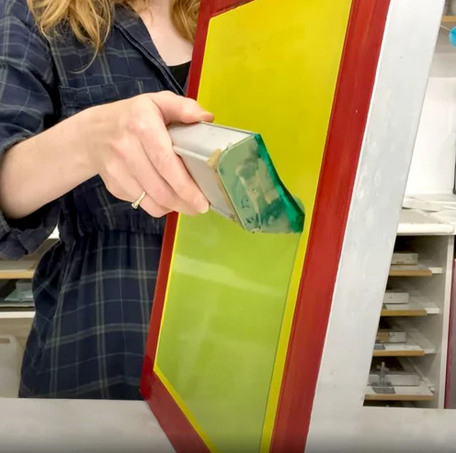
Photosensitive emulsion is the core component of screen printing, enabling the creation of precise stencils on mesh screens. When exposed to UV light, the emulsion hardens in uncovered areas while remaining water-soluble where protected by your design. This process allows ink to pass through only specific areas during printing.
Choosing the right emulsion, proper mixing, and correct exposure techniques are critical for achieving sharp, durable prints. This guide covers everything from emulsion chemistry to advanced troubleshooting methods.

Types of Photosensitive Emulsions
Different emulsions are formulated for specific ink types and printing conditions:
1. Water-Based Emulsions
Best for beginners and water-based inks:
- Easy cleanup: Removes with water, no harsh chemicals needed
- Ideal for textiles and paper: Perfect for art prints and cotton fabrics
- Lower chemical resistance: Not suitable for solvent inks
2. Solvent-Resistant Emulsions
Designed for plastisol and solvent inks:
- High durability: Withstands long print runs
- Requires special reclaiming: Needs emulsion removers
- Industrial applications: Used for apparel and posters
3. Dual-Cure Emulsions
Hybrid versatility:
- Works with both water-based and plastisol inks
- Longer shelf life than water-based emulsions
- Requires dichromate sensitizer (check local regulations)
Pro Tip:
Diazo-sensitized emulsions typically need 4-12 hours after mixing before use for complete chemical activation.
Emulsion Preparation
Proper mixing ensures even sensitivity and coating performance:
1. Mixing Procedure
- Add sensitizer slowly (usually 5-8% by volume)
- Stir gently for 5 minutes (avoid bubbles)
- Let mixture mature for 2-4 hours before use
2. Storage Guidelines
- Store at 60-75°F (15-24°C)
- Keep in amber bottles or foil-wrapped containers
- Use clean tools to prevent contamination
Warning!
Never mix different emulsion brands or types. Crystallization or separation may occur.
Screen Coating Techniques
Coating method affects stencil thickness and detail reproduction:
1. Screen Preparation
- Degrease mesh with specialized cleaners
- Rinse thoroughly and dry completely
- Handle screens with gloves to prevent oil transfer
2. Coating Methods
| Method | Description | Best For |
|---|---|---|
| Single Pass | One application on print side | Simple designs, high mesh counts |
| Double Pass | Two coats (print side + squeegee side) | Detailed artwork, longer runs |
| Wet-on-Wet | Second coat applied before first dries | Extra thick stencils |
UV Exposure Process
Precision exposure creates perfect stencils:
1. Exposure Calculation
Use this formula as starting point:
Exposure Time (sec) = (Mesh Count ÷ Light Intensity) × Base Factor
Where:
- Mesh Count: Threads per inch (e.g., 160T)
- Light Intensity: mW/cm² (measure with radiometer)
- Base Factor: 1.5-3.0 (varies by emulsion)
2. Step Wedge Test
Determine optimal exposure with 21-step test:
- Place step wedge film on coated screen
- Expose in 10-second increments
- Wash out and identify last clear step
- Multiply step number by 10 for ideal exposure
Advanced Tip:
For halftones, reduce exposure time by 15-20% to maintain dot integrity.
Troubleshooting Common Issues
1. Underexposure Problems
- Symptom: Emulsion washes out completely
Solution: Increase exposure time or check UV source - Symptom: Stencil edges breaking down
Solution: Add 10-15% more exposure
2. Overexposure Issues
- Symptom: Difficult washout
Solution: Reduce time or increase water pressure - Symptom: Lost fine details
Solution: Decrease exposure by 20%
3. Coating Defects
- Symptom: Pinholes
Solution: Filter emulsion, clean coating area - Symptom: Streaks
Solution: Maintain consistent coating speed
Conclusion
Mastering photosensitive emulsion transforms screen printing results. By selecting the proper emulsion type, perfecting coating techniques, and dialing in exposure times, you'll achieve professional-quality stencils consistently. Remember that environmental factors (humidity, temperature) significantly affect outcomes - keep detailed notes for repeatable success.

Leave a Comment